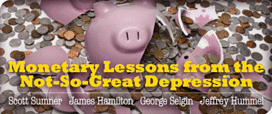On the causes of the crisis, Sumner asserts that the villains lost large amounts of their own money. Some did, but others made out very well indeed personally while losing vast sums of other people’s money. That latter feature identifies some profound incentive problems that need to be corrected. Getting into those in detail would distract us a bit from the interesting main thesis to which Sumner directs our attention, and I’m sure we’d find many areas of agreement as well as some disagreements if we pursued those questions in more depth. But for this forum I will simply reiterate my conviction that these problems in financial markets were a key cause of our present problems, and are not well described as a failure of monetary policy as conventionally understood in the sense that they did not result primarily from wrong values chosen for interest rates, inflation, or the money supply in the events leading up to September 2008.
The core question to be discussed here is what the Fed might have done differently beginning in September 2008. I am challenging the suggestion that the nominal growth rate of GDP for 2008:Q4 represents a magnitude that the Fed could have chosen to be whatever it wished in September 2008, had it only followed the right policy or operated within the right institutional environment.
I have studied the additional material on the GDP-futures targeting idea that Sumner suggested I look at, but confess I remain as perplexed as before about how exactly this is supposed to work. My basic confusion may arise from the fact that I think of private participation in futures markets as determining an equilibrium price of the contract, whereas Sumner is evidently thinking that the quantity of such contracts is itself a relevant magnitude to which the Fed might make a quantitative response. With equally informed risk-neutral speculators, there would be an infinite demand for one side of the contract at any price other than that which corresponds to the expected GDP growth rate, and zero demand at the equilibrium price. One can write down more complicated models with heterogeneous beliefs, risk aversion, and liquidity constraints, that do have particular implications for the quantities of contracts held in equilibrium, but I am most doubtful that a tight argument can be made relating the volume of positions taken on one side to a specific targeted economic objective.
I reiterate that the main question is whether the Fed, by whatever mechanism, has the capacity to control the expiry value of the contract, that is, the capacity to control the value of nominal GDP. Insofar as it does not, I do not see how any such scheme can work. Let me try to make the point by taking the argument to its logical extreme. Suppose we decided that we’re really unsatisfied with the orbit of Mars around the sun, and propose that the Fed needs to take responsibility for setting it right. We then set up a futures contract and allow market participants to wager on where Mars will be one year hence, and propose that the Fed shall make open market operations on the basis of some scheme relating to the price or quantity of such wagers. If we are clever enough at designing this scheme, will it deliver the path that we might prefer Mars to follow?
Granted, this is a facetious example, since we know that the Fed in reality has no control whatever over the orbit of Mars, but it seems to have something to do with the growth rate of nominal GDP. Granted too that expectations play a role in that influence the Fed has on nominal GDP. But it is equally clear to me that there are many things that happen to GDP that are not in the control of the Fed. After all, which number is it that the Fed is asserted to be able to control, the advance estimate, the revised estimate, or some Platonic truth that our best measures can only imperfectly reflect?
I grant that steps taken by the Fed in September 2008 might have affected the path of nominal GDP for 2008:Q4. But those same measures would have had much bigger consequences for subsequent prices and output. The more wildly one tried to adjust those magnitudes that are directly in control of the Fed in a futile bid to achieve a particular target it cannot control, whether it be 2008:Q4 nominal GDP or the 2009:Q4 position of Mars, the more instability it would introduce into the real economy.
I therefore come back to my suggestion that it is necessary to spell out the mechanism by which the Fed’s actions alter the course of nominal GDP. Sumner is welcome to describe changes in velocity V as “monetary shocks,” if he so wishes. But it is another matter altogether to explain exactly how the Fed can prevent them.
My view is that the Fed lacks the power to control the orbit of Mars, and lacked in September 2008 any tools that could have delivered a 5% annual growth rate for nominal GDP for 2008:Q4.

